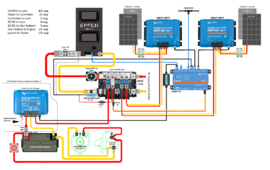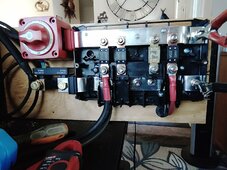OS2/Dude
New Member
This is my plan for replacing our current two 98Ah AGM batteries in a single bank with a 300Ah LFP battery with Victron Comms. It is all still sitting in my sunroom for the time being, but I hope to get up to the boat this spring to get it installed. I was going to go with a Buck-Boost so I could charge the LFP indirectly from the alternator, but that part is on hold for the time being. One AGM battery will be retained as a start battery for the inboard diesel. Unfortunately, not all items are to scale. Plan currently is to have a common ground. I also got two 115W bifacial panels on sale, so I may put the two 175W panels on one controller and the two 115W panels on the other.
I bought 8mm x 30mm x 200mm copper bar to make link bars to connect the 500A Victron SmartShunt IP65 and 650A Bluesea 3000 disconnect switch to the Victron Lynx. I also got a kit to nickel plate them. I am using 4/0 cable because the battery bank will be about 13 feet away from the Lynx.
I bought 8mm x 30mm x 200mm copper bar to make link bars to connect the 500A Victron SmartShunt IP65 and 650A Bluesea 3000 disconnect switch to the Victron Lynx. I also got a kit to nickel plate them. I am using 4/0 cable because the battery bank will be about 13 feet away from the Lynx.




